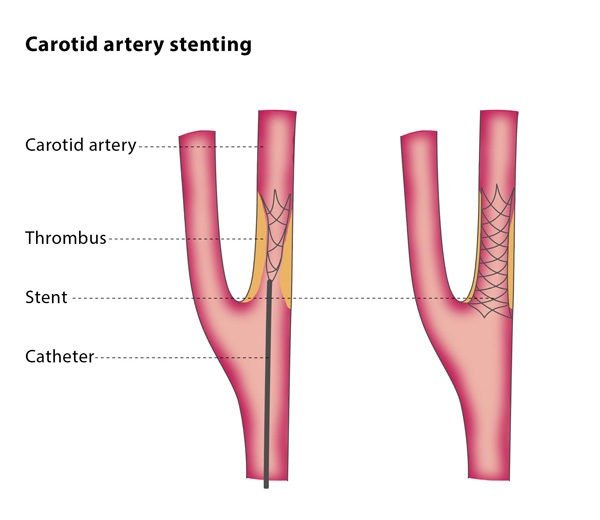Carotid Artery Stenting (CAS)

What is carotid artery stenosis/ disease?
Carotid artery is the main artery supplying blood to brain to function normally. If there is obstruction to the blood flow secondary to cholesterol deposition inside the wall of the carotid artery, brain doesn’t get enough blood to function to normal extent. This can lead to brain damage leading to stroke or transient ischemic attack (TIA). If left untreated, high risk of repeat stroke leading to significant disability.
What is Transient Ischemic Attacks or TIA?
In most cases, a TIA is caused by a tiny blood clot that becomes stuck in a small blood vessel (artery) in the brain. This blocks the blood flow, and a part of the brain is starved of oxygen. This leads to following symptoms:
- Weakness or clumsiness of a hand, arm, or leg.
- Difficulties with speech.
- Difficulties with swallowing.
- Numbness or pins and needles of a part of the body.
- Brief loss of vision, or double vision.
Most often these symptoms are transient and patient experiences complete recovery within 24 hours. But, these are often called as mini-strokes and patient must visit doctors to rule out underlying cause for TIA such as carotid artery stenosis.
What are the tests done for the diagnosis of carotid artery disease/ stenosis?
Carotid doppler: This is screening test to diagnose the any abnormality in carotid arteries. This is nothing but ultrasound/sonographic examination of neck region of the patient.
CT/MR Angiogram: If any abnormality id suspected in carotid doppler, patient will need CT angiogram. This will give more detailed information to guide the physician regarding the treatment of the stroke/TIA.
DSA: Few patients who need surgery, might need to undergo cerebral angiogram/DSA for more detailed assessment.
What are the treatment options for carotid artery stenosis/ disease?
Treatment is generally decided by patient’s symptoms, risk factors and result of above mentioned tests. If the blockages are more than 50% on CT angiogram, patient need to undergo treatment in the form of surgery. If it is less than 50%, then medical management in the form of blood thinning medications, lipid lowering agents ,risk factor management ( hypertension/ diabetes) and lifestyle modification is advisable.
What form of surgery is advisable for carotid artery disease?
There are two form of the surgical options. Carotid endarterectomy and carotid artery stenting. Endarterectomy is an open operation. This means the surgeon has to open up the artery (via a cut in the skin) to remove the blockages inside the artery
Carotid artery stenting is minimal invasive way to open the blockages of blood vessel by putting mesh like material (STENT). It is safer as compared to carotid endarterectomy without any scar of the surgery. Patient with TIA should visit specialist (Interventional Neuroradiologist) to know in more detail regarding each treatment options.

